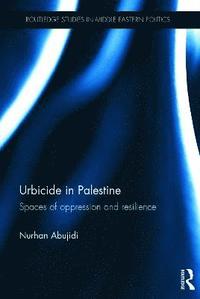
- Format
- Inbunden (Hardback)
- Språk
- Engelska
- Antal sidor
- 274
- Utgivningsdatum
- 2014-02-27
- Förlag
- Routledge
- Illustratör/Fotograf
- black and white 82 Halftones
- Illustrationer
- 82 Halftones, black and white
- Dimensioner
- 234 x 160 x 20 mm
- Vikt
- Antal komponenter
- 1
- Komponenter
- 52:B&W 6.14 x 9.21in or 234 x 156mm (Royal 8vo) Case Laminate on White w/Gloss Lam
- ISBN
- 9780415627054
- 522 g
Urbicide in Palestine
Spaces of Oppression and Resilience
- Skickas från oss inom 7-10 vardagar.
- Fri frakt över 249 kr för privatkunder i Sverige.
Passar bra ihop
De som köpt den här boken har ofta också köpt Knife av Salman Rushdie (inbunden).
Köp båda 2 för 2666 krKundrecensioner
Recensioner i media
"Nevertheless, there is much of value in this book beyond the specific case of Nablus, especially where the author focuses on acts of what she calls spatial resistance, including movements of symbolic return to destroyed and depopulated villages in historic Palestine and the deployment of counter-knowledge to subvert the Israeli regime of surveillance and control. Notably, she also discusses the re-coloniing movement of Bab al-Shams, when for a few months in the winter and spring of 2013, several tent villages were erected by Palestinian and international activists on lands marked for confiscation and the building of Israeli colonies, particularly in the Jordan Valley. The author sees great potential for this form of rhizomatic resistance (following Deleuze and Guattari) that she sees echoed in the 2011 Egyptian uprising, the Indignado movement in Spain, and the various Occupy protests in the US." Lisa Taraki
Övrig information
Nurhan Abujidi received her PhD in Architecture, urban design and regional planning from the Catholic University of Leuven Belgium. She is currently a visiting professor at the Catholic University of Leuven. She worked as Director, Research Director and International Relations Coordinator at the school of Architecture, San Jorge University Spain. She is Associate researcher with the COSMOPLIS research group on City, Culture and Society at the VUB Brussels Belgium working on the areas of military urbanism and Architecture of Resistance.
Innehållsförteckning
Part I: Introduction: Experiencing Spaces of Oppression and Resistance 1 Cities & War 2 Urbicide: Theoretical Inquiry Part II: Urbicide in Palestine 3 History of Urban/ Territorial Destruction in Palestine 1948-2002 Part III: Nablus 4 Nablus: Historical Perspective 5 Nablus: a City of Heritage 6 Nablus: Urbicide 2002-2005 Part IV: Revisions 7 Urbicide, States of Exception and Beyond 8 The Palestinian Resistance Discourse


